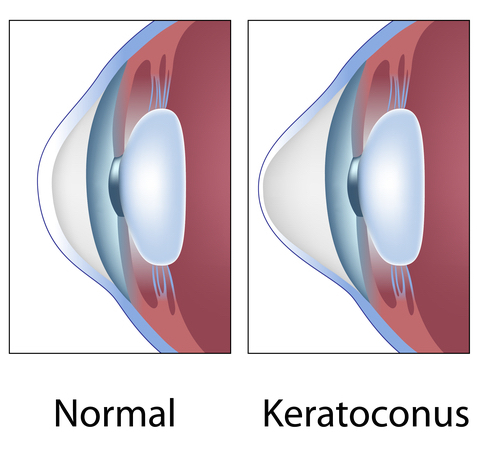Cornea
The eye is an incredible organ with various parts that all work together to enable you to see. One of the most important parts is the cornea.
Your eyesight can suffer when the cornea becomes damaged or doesn’t work correctly. Caring for your cornea should be a top priority for protecting your vision long-term.
What is the Cornea?
The cornea is the eye’s transparent outer layer, covering and protecting other parts like the iris and pupil. Its dome-shaped structure also serves as the eye’s “window,” directing or “refracting” light into it.
The cornea itself is made of six interactive layers of tissue. Each layer has a unique function, which blends with the functions of the other layers.
How Does the Cornea Work?
In its protective role, the cornea prevents foreign substances like debris or microorganisms from entering the eye’s interior. It also filters out some of the damaging ultraviolet rays emitted by the sun and aids in maintaining a normal fluid balance between itself and the rest of the eye.
The cornea’s other primary role is to direct incoming light in and through the pupil and lens toward the retina in the back of the eye. The retina then processes the incoming light into images transmitted from the optic nerve to the brain.
Dry Eye
 Chronic dry eye occurs when the eyes can’t produce enough tears, the tears produced evaporate too quickly, or the meibomian glands don’t make enough natural oil to maintain the protective tear film across the eye. As a result, people with dry eyes can experience a burning sensation, foreign body sensation, blurriness, a watery sensation, or a heightened sensitivity to light, among other frustrating symptoms.
Chronic dry eye occurs when the eyes can’t produce enough tears, the tears produced evaporate too quickly, or the meibomian glands don’t make enough natural oil to maintain the protective tear film across the eye. As a result, people with dry eyes can experience a burning sensation, foreign body sensation, blurriness, a watery sensation, or a heightened sensitivity to light, among other frustrating symptoms.
Chronic dry eye can also impact the health of your cornea by increasing the chances of abrasions (scratches) or scarring on its surface.
If you suffer from dry eye, there are things both you and your ophthalmologist at Dominion Eye Care can do to help alleviate discomfort and increase tear flow. You can often manage symptoms by resting your eyes frequently or using warm compresses.
Some people also see a decrease in symptoms by increasing the intake of omega-3 fatty acids in their diet. Your eye doctor may also recommend supplementing your eyes’ natural tears with artificial tears or eye drops.
Artificial tears and eye drops can help reduce inflammation. The doctor may also prescribe prescription eye drops to reduce inflammation and help your eyes produce more tears. Your ophthalmologist may recommend punctal plugs in your tear ducts to improve or retain tear flow. Other options are available to help address the root causes of the surface dryness inflammation, including OptiLIGHT natural light therapy and TearCare.
Keratoconus
Keratoconus is an eye condition that causes the layers of the cornea to thin over time, weakening the integrity of its outer shape.
The cornea, which should look like a dome, starts resembling a cone. Being cone-shaped distorts the incoming light, resulting in blurry or double vision, nearsightedness, or extreme sensitivity to light.

The causes of keratoconus aren’t entirely known, but most researchers believe a combination of genetics, hormones, and the environment plays a role. People with keratoconus usually notice problems in early adulthood as their eyesight progressively worsens.
Glasses or contact lenses can help compensate for these changes in their vision, and a surgical treatment called corneal cross-linking can help halt the progression of the eye condition. In more severe cases of keratoconus, a corneal transplant may be necessary.
Corneal Dystrophy
Corneal dystrophy is a term for a group of rare diseases that affect the cornea in different ways. Although total blindness is a possibility, it’s rarely the outcome.
Instead, patients with corneal dystrophy are more likely to experience a drop in sharpness and clarity in their vision. Corneal dystrophy leads to a buildup of opaque material within the layers of the cornea.
Patients can address moderate symptoms of corneal dystrophy with medicated drops or ointments.
But as with keratoconus, worsening symptoms could make a partial or full corneal transplant an option to consider.
Corneal Ectasia
Corneal ectasia is a group of conditions that occur when the cornea’s tissues begin to thin, often because of keratoconus, a corrective eye procedure, infection, or injury. The eye’s typical fluid presses against this thin spot, often creating a cone-shaped bulge in the cornea.
Besides blurring, double vision, or nearsightedness, patients may experience a rapid deterioration of their eyesight (and a widening difference in visual clarity between each eye), resulting in more frequent changes to their corrective lens prescription. They may also experience headaches after focused use of their eyes, like when reading or driving.
Besides compensating for vision changes with corrective glasses or contact lenses, patients with mild to moderate ectasia may undergo surgery to strengthen the corneal tissue and stop the disease progression. In more serious cases, patients may need to consider a corneal transplant.
Pterygium
Pterygium is a raised growth of tissue that may develop on the conjunctiva, a transparent membrane covering the white portion of your eye (sclera). It’s mainly caused by long-term exposure to ultraviolet rays and most often occurs in people who are out in the sun for long periods of time.
Because spending time in the sun is connected to being on the water, it’s commonly called “surfer’s eye.” Pterygium can cause irritation, redness, dryness, or a feeling of grit in the eyes.
As it grows, it can become noticeable to others and lead to embarrassment. Pterygium can also grow onto the cornea, interfering with its ability to properly refract light, leading to possible blurriness or double vision.
Cases of pterygium are often treated with medicated drops or ointments to reduce symptoms. If the medication doesn’t relieve symptoms, or the pterygium continues to grow or interfere with the cornea, surgery may be necessary to remove the growth.
Do you need a corneal condition treated? Learn more by requesting your appointment at Dominion Eye Care in Manassas and Warrenton, VA, today!

